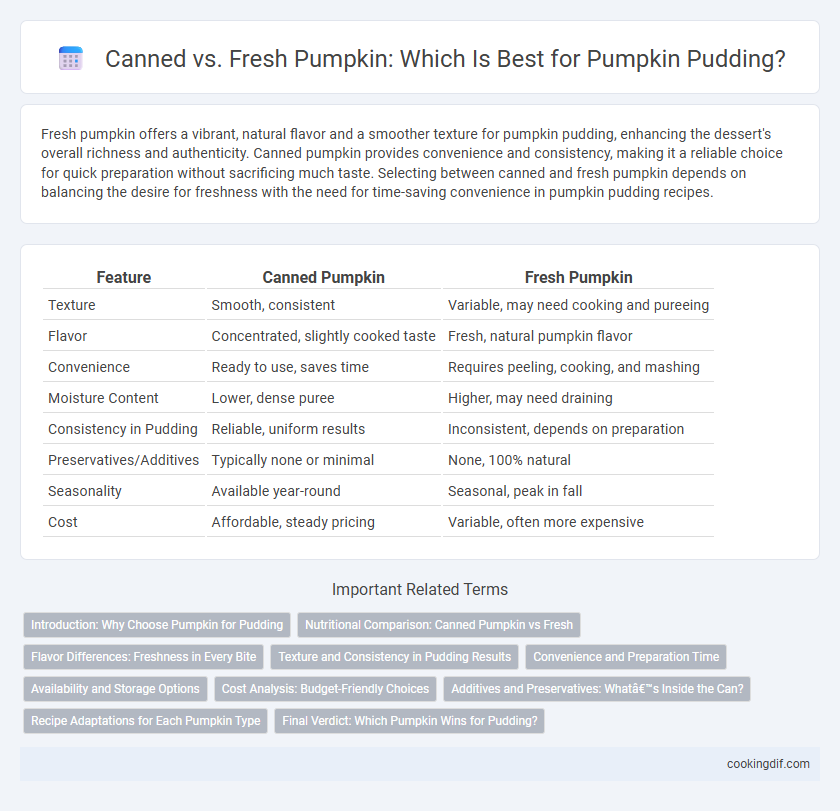Fresh pumpkin offers a vibrant, natural flavor and a smoother texture for pumpkin pudding, enhancing the dessert's overall richness and authenticity. Canned pumpkin provides convenience and consistency, making it a reliable choice for quick preparation without sacrificing much taste. Selecting between canned and fresh pumpkin depends on balancing the desire for freshness with the need for time-saving convenience in pumpkin pudding recipes.
Table of Comparison
| Feature | Canned Pumpkin | Fresh Pumpkin |
|---|---|---|
| Texture | Smooth, consistent | Variable, may need cooking and pureeing |
| Flavor | Concentrated, slightly cooked taste | Fresh, natural pumpkin flavor |
| Convenience | Ready to use, saves time | Requires peeling, cooking, and mashing |
| Moisture Content | Lower, dense puree | Higher, may need draining |
| Consistency in Pudding | Reliable, uniform results | Inconsistent, depends on preparation |
| Preservatives/Additives | Typically none or minimal | None, 100% natural |
| Seasonality | Available year-round | Seasonal, peak in fall |
| Cost | Affordable, steady pricing | Variable, often more expensive |
Introduction: Why Choose Pumpkin for Pudding
Pumpkin's rich texture and naturally sweet flavor make it an ideal base for creamy pumpkin pudding. Choosing between canned and fresh pumpkin impacts the pudding's consistency and taste, as canned pumpkin offers convenience and uniformity, while fresh pumpkin provides a fresher, more vibrant flavor and control over texture. Understanding the differences helps achieve the perfect balance of sweetness and creaminess in pumpkin pudding recipes.
Nutritional Comparison: Canned Pumpkin vs Fresh
Canned pumpkin contains a consistent nutrient profile with high levels of fiber, vitamin A, and potassium, making it a convenient choice for pumpkin pudding. Fresh pumpkin offers a slightly higher vitamin C content and natural moisture, but requires more preparation time and may vary in nutrient density depending on ripeness. Both options provide antioxidants and essential nutrients, yet canned pumpkin ensures stable quality and prolonged shelf life for consistent pudding recipes.
Flavor Differences: Freshness in Every Bite
Fresh pumpkin offers a vibrant, natural sweetness and a slightly earthy flavor that enhances the authenticity of pumpkin pudding, preserving the vegetable's original taste profile. Canned pumpkin delivers consistent texture and convenience but often lacks the nuanced, bright freshness that fresh pumpkin brings to each bite. Choosing fresh pumpkin ensures a more dynamic and flavorful pudding with richer aroma and complexity.
Texture and Consistency in Pudding Results
Canned pumpkin delivers a smooth, consistent texture in pumpkin pudding due to its uniform puree and moisture content. Fresh pumpkin often results in a thicker, chunkier texture unless properly cooked and pureed, which can affect the pudding's creaminess. Using canned pumpkin provides more predictable consistency, enhancing the pudding's velvety quality.
Convenience and Preparation Time
Canned pumpkin offers unmatched convenience and significantly reduces preparation time, making it a preferred choice for quick pumpkin pudding recipes. Fresh pumpkin requires peeling, cooking, and pureeing, which can extend prep time by 30 to 60 minutes. Using canned pumpkin ensures a smooth texture and consistent flavor while streamlining the cooking process.
Availability and Storage Options
Canned pumpkin offers consistent availability year-round and comes pre-cooked, making it a convenient option for pumpkin pudding recipes. Fresh pumpkin requires seasonal availability and must be peeled, cooked, and pureed before use, but it allows for customization of texture and flavor. Storage-wise, canned pumpkin has a long shelf life and can be stored at room temperature until opened, while fresh pumpkin needs to be refrigerated and used within a few days or frozen for longer preservation.
Cost Analysis: Budget-Friendly Choices
Canned pumpkin offers a more budget-friendly option for pumpkin pudding due to its consistent pricing and year-round availability, often costing less per ounce compared to fresh pumpkin. Fresh pumpkins require peeling, cooking, and pureeing, which adds time and energy costs that can increase the overall expense. For cost analysis, canned pumpkin provides convenience and savings, making it an economical choice for those prioritizing affordability in pumpkin pudding recipes.
Additives and Preservatives: What’s Inside the Can?
Canned pumpkin often contains additives and preservatives such as calcium propionate and sodium benzoate to extend shelf life and prevent mold growth, while fresh pumpkin is free from these chemicals. The presence of these additives can subtly alter the flavor and texture of pumpkin pudding, sometimes affecting the natural sweetness and creaminess desired in the dish. Choosing fresh pumpkin ensures a pure, additive-free pudding experience, whereas canned pumpkin offers convenience at the cost of potential preservative residues.
Recipe Adaptations for Each Pumpkin Type
Canned pumpkin provides a consistent texture and moisture level, allowing for straightforward recipe adjustments in pumpkin pudding by using the standard proportions listed in most recipes. Fresh pumpkin requires roasting and pureeing, which can alter the moisture content, so recipes often call for reducing added liquids to achieve the desired pudding consistency. To optimize flavor and texture with fresh pumpkin, increasing spices like cinnamon and nutmeg compensates for its milder taste compared to the concentrated richness of canned pumpkin.
Final Verdict: Which Pumpkin Wins for Pudding?
Canned pumpkin delivers consistent texture and flavor, making it the preferred choice for smooth, creamy pumpkin pudding with reliable sweetness and moisture. Fresh pumpkin requires roasting and pureeing, which can result in varied textures and a more subtle natural flavor, often requiring adjustments in sugar and spices. For convenience, consistency, and optimal pudding quality, canned pumpkin wins as the best option.
Canned vs Fresh pumpkin for pumpkin pudding Infographic

 cookingdif.com
cookingdif.com